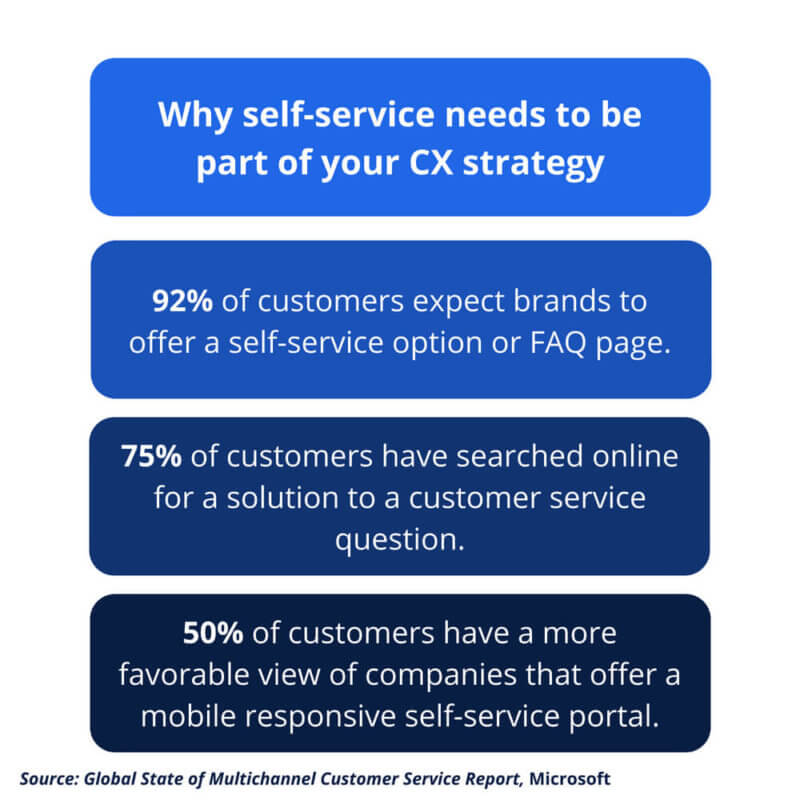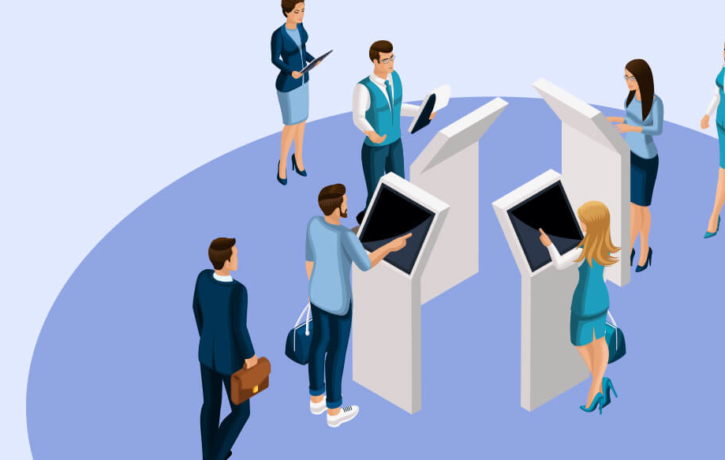My dad recently told me he’s never used an ATM in his life.
I was incredulous. I almost exclusively use ATMs, only stepping foot inside my bank when absolutely necessary.
Automated teller machines have been one of the most widely used forms of self-service technology since their debut in in 1967.
 The beauty of the self-service phenomenon is that it kills two birds with one stone. It answers customers’ need for convenience and speed while lowering overhead costs. It also frees up company staff to focus on the high-touch interactions that influence the overall customer experience.
On the flip side, companies that do not offer self-service will quickly fall behind competitors.
The beauty of the self-service phenomenon is that it kills two birds with one stone. It answers customers’ need for convenience and speed while lowering overhead costs. It also frees up company staff to focus on the high-touch interactions that influence the overall customer experience.
On the flip side, companies that do not offer self-service will quickly fall behind competitors.
 In the digital age, the average American spends 23.6 hours per week online, according to the Center for the Digital Future.
Issues are bound to arise when people spend this much time using digital tools. Users want a solution that is convenient and efficient.
People don’t just prefer a self-service option, they expect it.
In the digital age, the average American spends 23.6 hours per week online, according to the Center for the Digital Future.
Issues are bound to arise when people spend this much time using digital tools. Users want a solution that is convenient and efficient.
People don’t just prefer a self-service option, they expect it.

 Workplace technology can be a serious source of frustration and stress. Self-service tools remedy this issue because they help users quickly and efficiently find solutions when they encounter friction.
Whether they get stuck on a process, make an error, or attempt to use an unfamiliar feature, self-service helps prevent confusion and improve the user experience.
The result is lower employee stress, greater productivity, and fewer support tickets.
Workplace technology can be a serious source of frustration and stress. Self-service tools remedy this issue because they help users quickly and efficiently find solutions when they encounter friction.
Whether they get stuck on a process, make an error, or attempt to use an unfamiliar feature, self-service helps prevent confusion and improve the user experience.
The result is lower employee stress, greater productivity, and fewer support tickets.
 Or imagine your employee needs to complete a task on your HCM platform. However, your cloud-based system recently released an upgrade, and now your employee doesn’t know where to click to begin the process.
If you had a Digital Adoption Platform (DAP), it could send a pop-up prompt to guide your user. Using machine learning and artificial intelligence, the DAP would know which functions your employee usually needs. It would ask if she wants to complete one of those tasks, then guide her through it using highlights and pop-up instruction prompts.
No need to flag down IT, no need to ask a colleague for help. Your employee has the tools she needs to solve the issue herself.
Or imagine your employee needs to complete a task on your HCM platform. However, your cloud-based system recently released an upgrade, and now your employee doesn’t know where to click to begin the process.
If you had a Digital Adoption Platform (DAP), it could send a pop-up prompt to guide your user. Using machine learning and artificial intelligence, the DAP would know which functions your employee usually needs. It would ask if she wants to complete one of those tasks, then guide her through it using highlights and pop-up instruction prompts.
No need to flag down IT, no need to ask a colleague for help. Your employee has the tools she needs to solve the issue herself.
 Your IT and customer support personnel must be prepared to solve more challenging problems. This means they must possess soft skills to calm frustrated customers. It probably also means you need to provide better training, or pay more to hire more qualified staff.
Another question to consider is what to do with the additional capacity your self-service strategy will produce.
Leaders must decide how to use the freed up capacity. Some might take the cost savings opportunity to hire fewer workers. But the most strategic technology leaders will evolve employees’ roles to take on more interesting tasks and work alongside self-service tools.
Your IT and customer support personnel must be prepared to solve more challenging problems. This means they must possess soft skills to calm frustrated customers. It probably also means you need to provide better training, or pay more to hire more qualified staff.
Another question to consider is what to do with the additional capacity your self-service strategy will produce.
Leaders must decide how to use the freed up capacity. Some might take the cost savings opportunity to hire fewer workers. But the most strategic technology leaders will evolve employees’ roles to take on more interesting tasks and work alongside self-service tools.
Raise your customer experience to new heights with self-service tools.
My dad is an outlier. Most people would prefer to use an ATM than make a trip to the bank, fill out a form, and wait in line just to withdraw cash. As more aspects of people’s work and personal lives become digitized, what was once a preference for self-service has become the expectation. The beauty of the self-service phenomenon is that it kills two birds with one stone. It answers customers’ need for convenience and speed while lowering overhead costs. It also frees up company staff to focus on the high-touch interactions that influence the overall customer experience.
On the flip side, companies that do not offer self-service will quickly fall behind competitors.
The beauty of the self-service phenomenon is that it kills two birds with one stone. It answers customers’ need for convenience and speed while lowering overhead costs. It also frees up company staff to focus on the high-touch interactions that influence the overall customer experience.
On the flip side, companies that do not offer self-service will quickly fall behind competitors.
Self-service drives self-sufficiency
Self-service capabilities aren’t limited to ATMs and other standalone technology. They can be integrated into various digital tools, such as enterprise software, mobile apps, and online stores. Gartner defines self-service as “a blend of customer-initiated interaction technologies that are designed to enable customers to service themselves.” Some examples include chatbots, context-sensitive guidance prompts, FAQ pages, and knowledge bases. These capabilities eliminate the need for users to call customer support or IT every time a problem arises by enabling them to solve simple issues on their own. They also unleash new efficiencies in your customer support and IT help desk. Instead of clogging your support teams’ workflow with low-touch, mundane queries, they can use their expertise to focus on high-touch help cases.Consumers are demanding a self-service option
 In the digital age, the average American spends 23.6 hours per week online, according to the Center for the Digital Future.
Issues are bound to arise when people spend this much time using digital tools. Users want a solution that is convenient and efficient.
People don’t just prefer a self-service option, they expect it.
In the digital age, the average American spends 23.6 hours per week online, according to the Center for the Digital Future.
Issues are bound to arise when people spend this much time using digital tools. Users want a solution that is convenient and efficient.
People don’t just prefer a self-service option, they expect it.
- 92% of U.S. customers expect a brand or organization to offer self-service (Microsoft)
- 50% of U.S. customers have a more favorable view of companies that offer a mobile responsive self-service portal (Microsoft)
- Nearly 75% of consumers would rather solve customer service issues themselves, instead of relying on customer support (Aspect)

Self-service drives customer loyalty
Offering a self-service option shows your customers that you value their time. It demonstrates a strong commitment to the customer experience, which helps drive retention. People want a seamless, efficient digital experience. Whether they’re shopping, online banking, or using enterprise software, users expect technology to work for them. When they experience friction, they want around-the-clock access to help services. At the same time, they want these services to be as unobtrusive and efficient as possible. Technology that enables self-service supports this seamless experience. The end result is a better customer experience and a more meaningful relationship with your brand.Enterprise tools need a self-service solution
The digital workplace is a hotbed of technology. Businesses often have digital systems for human resources, customer relationship management, finance, business intelligence, and more. For employees, gaining proficiency on multiple platforms is a major challenge. Workplace technology can be a serious source of frustration and stress. Self-service tools remedy this issue because they help users quickly and efficiently find solutions when they encounter friction.
Whether they get stuck on a process, make an error, or attempt to use an unfamiliar feature, self-service helps prevent confusion and improve the user experience.
The result is lower employee stress, greater productivity, and fewer support tickets.
Workplace technology can be a serious source of frustration and stress. Self-service tools remedy this issue because they help users quickly and efficiently find solutions when they encounter friction.
Whether they get stuck on a process, make an error, or attempt to use an unfamiliar feature, self-service helps prevent confusion and improve the user experience.
The result is lower employee stress, greater productivity, and fewer support tickets.
How do these tools work?
Self-service can come in many forms. It can be as basic as an FAQ page that provides solutions to common problems. It can be a business’s “community” platform, where users can communicate with one another and experts within the company. Artificial intelligence, machine learning, and automation create more sophisticated self-service opportunities. Chatbots and context-sensitive guidance prompts are great options because they are proactive and deliver help in real time.Self-service in action
Imagine you’re the CIO of a bank. One of your customers is trying to make a transfer via his online portal, but he gets stuck. He can’t proceed because he doesn’t know the routing number for the account from which he wants to send the money. Without a self-service option, your customer might call the bank for help. Or he would navigate away from the page to look it up, only to start the process over again later. Instead, what if he could ask a chatbot that appears onscreen? After using the customer’s security questions to identify his account, the chatbot could send him the routing number in a verified message. Or imagine your employee needs to complete a task on your HCM platform. However, your cloud-based system recently released an upgrade, and now your employee doesn’t know where to click to begin the process.
If you had a Digital Adoption Platform (DAP), it could send a pop-up prompt to guide your user. Using machine learning and artificial intelligence, the DAP would know which functions your employee usually needs. It would ask if she wants to complete one of those tasks, then guide her through it using highlights and pop-up instruction prompts.
No need to flag down IT, no need to ask a colleague for help. Your employee has the tools she needs to solve the issue herself.
Or imagine your employee needs to complete a task on your HCM platform. However, your cloud-based system recently released an upgrade, and now your employee doesn’t know where to click to begin the process.
If you had a Digital Adoption Platform (DAP), it could send a pop-up prompt to guide your user. Using machine learning and artificial intelligence, the DAP would know which functions your employee usually needs. It would ask if she wants to complete one of those tasks, then guide her through it using highlights and pop-up instruction prompts.
No need to flag down IT, no need to ask a colleague for help. Your employee has the tools she needs to solve the issue herself.
3 self-service best practices
Consider these tips before creating your self-service strategy.1. Make it proactive and convenient
Self-service tools should be intuitive and effortless. Don’t make your users learn or work hard to use them — they’re supposed to resolve friction, not add to it. In a fast-paced digital world, people have no patience for delays. The majority of customers (73%) say valuing their time is the most important aspect of customer service, according to Forrester. Make sure your self-service option can proactively deliver relevant, useful information with a minimal number of clicks.2. Make personalization a key feature
Your users’ needs should be at the core of your self-service offering. Data, such as user history and context, should inform personalized troubleshooting and guidance. The more a user interacts with your self-service solution, the more it can learn and offer personalized support.3. Remember that it’s only part of your support strategy
Self-service should complement, not replace your human support services. Giving users a self-service option can enhance their experience and minimize frustration, but nothing can replace human-to-human interactions. There will be circumstances when the easiest and most effective solution is not a chatbot, but talking to IT or customer support.The implications of self-service
Adding self-service capabilities can create new efficiencies internally and improve your customer experience, but there are also some implications to think about. Because self-service technology handles the simple, low-touch issues, the inquiries that reach human support agents will be more complex. Your IT and customer support personnel must be prepared to solve more challenging problems. This means they must possess soft skills to calm frustrated customers. It probably also means you need to provide better training, or pay more to hire more qualified staff.
Another question to consider is what to do with the additional capacity your self-service strategy will produce.
Leaders must decide how to use the freed up capacity. Some might take the cost savings opportunity to hire fewer workers. But the most strategic technology leaders will evolve employees’ roles to take on more interesting tasks and work alongside self-service tools.
Your IT and customer support personnel must be prepared to solve more challenging problems. This means they must possess soft skills to calm frustrated customers. It probably also means you need to provide better training, or pay more to hire more qualified staff.
Another question to consider is what to do with the additional capacity your self-service strategy will produce.
Leaders must decide how to use the freed up capacity. Some might take the cost savings opportunity to hire fewer workers. But the most strategic technology leaders will evolve employees’ roles to take on more interesting tasks and work alongside self-service tools.

